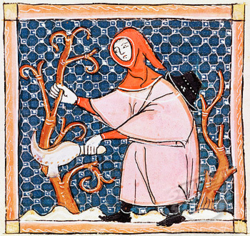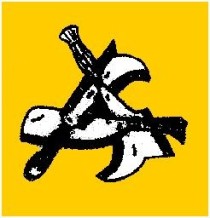The dictionary definition of a billhook.....
Bill-hook: (bi-l,huk)
1611 [f. bill sb.1] A heavy thick knife or chopper with a
hooked end, used for pruning etc.
Bill: (bil) sb.1
[OE. bil = OS. bil, OHG bil (MHG. ; but G. bille fem., axe) :- WGme.
bilja 1. A kind of sword mentioned in OE. poetry. 2. An obsolete weapon carried by soldiers and watchmen varying in form from a concave blade with a long handle, to a
kind of concave axe with a spike at the back and its shaft ending in a spearhead; a halberd ME. 3. Short for BILLMAN 1495. 4. An implement having a long blade with a concave
edge (cf. BILL-HOOK), used for pruning, cutting wood etc. OE. 5. A pickaxe - 1483.
A billhook is a generally seen as a short cutting tool (bill) with a curved nose (hook), and the majority
of billhooks, english or foreign, are easily recognisable as being of this shape, but in fact this definition is not correct as billhook comes from 'hackbeil' a German word for a
chopping tool (see hookbill, below, and Etymology)
The billhook ( or bill-hook) is also known as a hand-bill in some english counties and hedging-bill in others.
The OED also gives hook-bill, and hack, and in parts of Dorset and Devon they are still known a hackers. Double edged bills, i.e. those
with a second blade at the back, are referred to as broom-hooks by some makers. The straight edge of the back blade allows cutting against a block or log, whereas
the nose of a curved blade would dig in and prevent contact between the straight part of the blade and the chopping surface. A broom hook would be of great use to a broom squire, the name
for those who made besom brooms, for trimming the head of the broom against a block. Some special bills are made without the hook, i.e. a single straight blade, similar in shape to
meat cleavers used by butchers, others have an additional hook on the end or the rear of the blade which is useful for pushing branches into place when hedge-laying.
A small billhook, typically used by thatchers or coppice workers for splitting hazel gads and pointing the smaller piece of wood is known as spar hook. Spars or
broches are used by thatchers to fasten the thatch to the roof, and before use they are bent into a staple with an ingenious double twist which separates the fibres without damaging
them.
Billhooks are also known as pruning hooks, although these are generally smaller than the average sized bills. Some makers also offered gentleman's and lady's
billhooks, which were usually highly polished and fitted with more ornately turned handles, often made of imported hardwood, antler or horn. One such is the Milton hatchet, which is
double edged and unusual in having a single bevel on the back blade, similar to that found on a chisel.
Some billhooks have a single bevel on the cutting blade, e.g Kent or Suffolk patterns, but most are sharpened with a double bevel. Occasionally the blade may be cranked or
offset: this, or the way the single bevel is ground, mean that some types of hook were obtainable in left or right handed versions.


